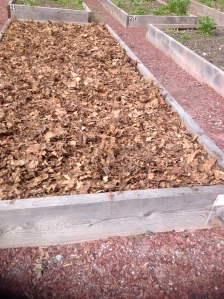
Today, Josh and I prepared the raised bed at our community garden. When we arrived at our little plot of land, the bed was bare, and had a few weeds growing. So, we pulled up the weeds, raked out some trash and dug down a bit to see what the soil was like. We did not see any evidence of worms or other small life forms. Yet, we know that alive and healthy soil is full of worms and other small critters. So we set out to fix that.
Josh and I went home to get some worms from our worm bin and some supplies in order to make them comfortable in their soon-to-be new home. When we returned, we dug a little trench down the center of the bed, and put in some red wigglers and many, many worm eggs. Then we covered them over with soil. Worms do not like sunshine! Next, we watered the soil. Worms do like moisture. Finally, we put on a layer of leaves to cover over the soil, and provide the worms with something to eat until the compost arrives.
A good friend of mine, and organic gardener, Moira Ryan, who we dearly miss, always advised, “Nowhere in nature, does bare soil exist”. That is to say, when soil is left bare, the life in it is destroyed and then the soil disappears. Many folks may not think of soil as alive, but it is. Amazingly, there is more life living in healthy soil, than can ever live on top of it. Healthy soil will be alive with worms, other small critters, micorrhizae, and all sorts of microbes that I have come to think of as ‘the micro-herd’. All of this life is desirable and we should encourage it and support it. This is the reason that when we garden, we try to disturb the soil as little as possible and this is why we keep it covered.
Once we finished preparing the bed and covering the soil, we then stepped back to see how nice it looked. We thought to ourselves that perhaps we might lose our leaf mulch if there was a big wind. That would not be a nice thing to happen to our neighbors, finding our leaves all over. So we topped it all off with some cardboard boxes. To hold them in place we used a few pieces of wood. A good rain would sure help the soil and the soil critters a great deal right now. We intend to keep the leaves and cardboard in place in order to retain soil moisture and to also keep the weeds down. An extra bonus of the mulching is that it will all eventually break down into new and healthy soil.
It is so nice to have fresh and healthy fruits and vegetables, but gardening, to us, is about much more than just growing food. This project will be a part of Josh’s homeschool curriculum. He can learn about horticulture and community building while working on this project. Furthermore, because the small act of gardening puts one in touch with nature, it is natural that he will be learning about environmental issues, too. In this way, our summertime fresh-food project will be a hobby that produces, rather than a hobby of consumption. Our little garden plot will produce fresh fruits and vegetables, some healthy outdoor exercise, plus an educational opportunity in the sciences, social studies, and in creation care. This is truly a More-with-Less adventure.
On Mother’s Day, my dear son and I plan to return to our little garden plot in order to install some fencing for trellis, and perhaps plant a few cold weather crops, too.
When we were done working today, Josh said, “This is fun!”
© Nancy Babbitt and Just Desserts Blog, 2013-2014. Unauthorized use and/or duplication of this material without express and written permission from this blog’s author and/or owner is strictly prohibited. Excerpts and links may be used, provided that full and clear credit is given to Nancy Babbitt and Just Desserts Blog with appropriate and specific direction to the original content.




